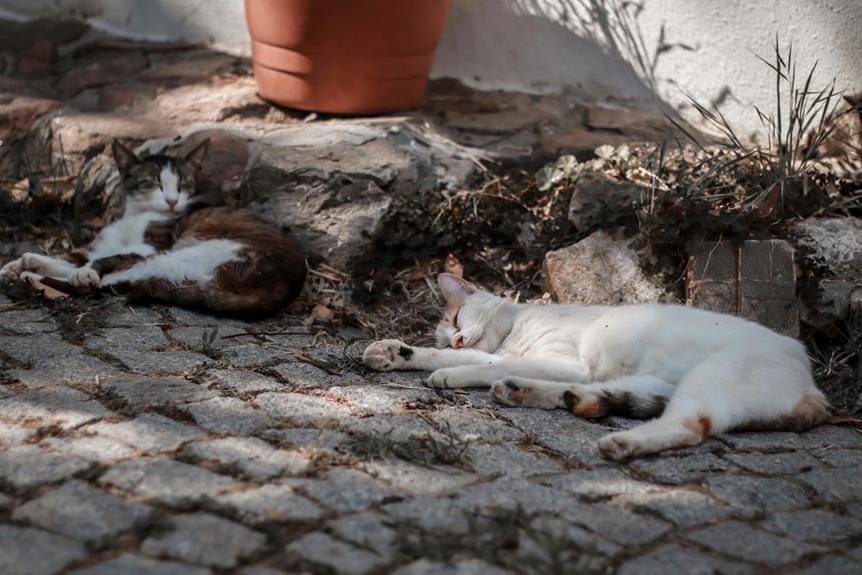
If your cat has behavioral issues, tackling common problems like excessive scratching, aggressive behavior, litter box issues, and excessive meowing is vital. Provide sturdy scratching posts, identify triggers of aggression, ensure clean litter boxes, and rule out health problems when your cat meows excessively. Understanding the root causes of these behaviors will help you address them effectively.
Excessive Scratching
If your cat is constantly scratching furniture and walls, it may be a sign of excessive scratching behavior. Cats have a natural instinct to scratch for various reasons, such as to mark their territory, stretch their muscles, and shed the outer layers of their claws. However, when this behavior becomes excessive and destructive, it can be a cause for concern.
To address this issue, provide your cat with appropriate scratching posts or pads. These should be sturdy, tall enough for your cat to fully stretch, and placed in areas where your cat likes to scratch. Encourage your cat to use these designated scratching surfaces by sprinkling catnip on them or using interactive toys to entice them. Additionally, you can trim your cat's claws regularly to minimize damage from scratching.
It's important not to punish your cat for scratching inappropriately, as this can lead to stress and anxiety. Instead, positively reinforce good scratching behavior and redirect any unwanted scratching to appropriate surfaces. By understanding and addressing your cat's scratching needs, you can help prevent excessive scratching behavior and maintain a harmonious environment in your home.
Aggressive Behavior
Aggressive behavior in cats can manifest in various ways, from hissing and swatting to biting and scratching. Cats may exhibit aggression due to fear, stress, pain, territoriality, or overstimulation. It's essential to address aggressive behavior promptly to prevent injuries to both humans and other pets in the household.
To address aggression in cats, start by identifying the triggers or situations that lead to the aggressive behavior. Avoid punishment as it can escalate the aggression further. Instead, provide your cat with a safe space where it can retreat and feel secure when feeling threatened. Implement interactive play sessions to help release excess energy and provide mental stimulation.
Consulting with a veterinarian is crucial to rule out any underlying medical conditions that might be causing the aggression. In some cases, your vet may recommend behavior modification techniques or medication to manage your cat's aggression effectively. Remember, patience, consistency, and positive reinforcement are key when addressing aggressive behavior in cats.
Litter Box Problems
When addressing litter box problems in cats, understanding the underlying reasons for their behavior is crucial. Cats may avoid the litter box due to various reasons like medical issues, dislike of the litter type, or stress. If your cat suddenly starts having accidents outside the litter box, it's essential to rule out any potential health problems by consulting a veterinarian. Once health issues are ruled out, consider the litter box itself. Cats can be picky about the type of litter, so try different textures and depths to see what your cat prefers.
Additionally, the location of the litter box plays a significant role. Cats prefer quiet, easily accessible areas for their litter boxes. Ensure you have enough litter boxes in multi-cat households, ideally one per cat plus one extra. Keep the litter boxes clean by scooping them daily and regularly changing the litter. If your cat continues to have issues, behavioral problems or stress could be the cause, and consulting with a feline behaviorist might be beneficial.
Excessive Meowing
Understanding common behavioral issues in cats, excessive meowing can be a sign of various underlying reasons that need to be addressed. Cats may meow excessively due to hunger, attention-seeking behavior, stress, or medical issues. If your cat is constantly meowing, the first step is to rule out any potential health problems by consulting with a veterinarian.
Once medical issues are ruled out, consider the cat's environment and routine. Cats thrive on consistency, so changes in their surroundings or daily schedule can lead to increased vocalization. Make sure your cat has enough mental and physical stimulation through playtime and interactive toys to prevent boredom. Additionally, ensure that your cat's basic needs such as food, water, and a clean litter box are met.
Providing a comfortable and safe space for your cat to retreat to when they feel overwhelmed can also help reduce excessive meowing. By addressing the underlying cause of your cat's excessive vocalization, you can help them feel more secure and content.
Conclusion
Overall, understanding the most common behavioral issues in cats and how to address them is crucial for a happy and harmonious relationship with your feline friend. By addressing issues such as excessive scratching, aggressive behavior, litter box problems, and excessive meowing, you can create a more positive environment for your cat and yourself.
Remember, patience, consistency, and positive reinforcement are key in addressing and resolving behavioral issues in cats.




